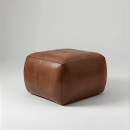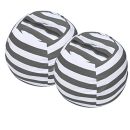
To clean a leather couch naturally, first, vacuum the surface, then create a solution of equal parts water and white vinegar. Gently wipe the leather using a soft cloth dipped in the solution, avoiding soaking the material.
Leather furniture adds a touch of elegance to any living space, but maintaining its pristine condition demands regular cleaning. Natural methods offer a safe and effective alternative to harsh chemicals, preserving both the couch’s appearance and the environment. These methods harness the power of household ingredients that are often readily available, reducing the need for specialized products.
Whether you’re tackling a routine clean or addressing a small stain, it’s important to approach your leather sofa with gentle care to maintain its integrity and comfort. Understanding the appropriate techniques for natural cleaning will ensure your leather couch remains a centerpiece in your home for years to come, without the use of harsh synthetic cleaners.
Introduction To Leather Care
Treating a leather couch with the respect it deserves not only maintains its luxurious feel and appearance but also extends its life. Understanding the unique material attributes of leather and employing natural cleaning methods can transform leather upkeep into a simple, eco-friendly practice. This section introduces core concepts of leather care that lay the foundation for effective, natural maintenance and cleaning strategies.
Understanding The Nature Of Leather
Leather, a durable and flexible material created by tanning animal rawhide, varies in its characteristics based on the type and treatment it undergoes during the manufacturing process. Grasping the nature of leather is essential for selecting the most suitable natural cleaning agents and methods:
- Porosity: Some Leather Types are more porous than others, which affects how they absorb liquids.
- Finish: The surface treatment of leather impacts its vulnerability to stains and wear.
- Age: Over time, leather may develop a patina or show signs of aging, which influences how it should be cared for.
Benefits Of Natural Cleaning Methods For Leather Couches
Natural cleaning methods can provide a multitude of benefits for your leather couch:
| Benefit | Description |
|---|---|
| Safety | Chemical-free solutions mean there’s less risk of damaging the leather or causing allergic reactions. |
| Eco-Friendly | Using natural ingredients reduces environmental impact and promotes sustainability. |
| Gentleness | Natural cleaners tend to be more gentle, preserving the leather’s integrity and softness. |
| Cost-Effectiveness | Many natural cleaning remedies include common household items, making them affordable and easily accessible. |
Adopting natural methods for leather care proves advantageous, not just for the maintenance of the material but also for the well-being of your home environment and the planet.
Preparation And Pre-cleaning Strategies
Cleaning a leather couch requires more than just diving in with a wet cloth. Opting for natural cleaning solutions not only helps in maintaining the luxurious look of your leather couch but also ensures that you are not harming the environment with harsh chemicals. Preparing properly and understanding the best pre-cleaning practices are essential steps that guarantee a safer, more effective cleaning. Let’s focus on how to prep your precious piece of furniture for a natural, thorough cleanse.
Gathering Eco-Friendly Cleaning Supplies
Before starting, it’s crucial to compile a set of tools and cleaners that will be tough on dirt, but gentle on both your leather and the planet. Here’s what you’ll need:
- Soft microfiber cloths to wipe down the leather without scratching it.
- A soft-bristled brush for loosening any dirt and debris lodged in the grain.
- White vinegar or certified organic leather cleaner as a natural cleaning agent.
- Pure olive oil for conditioning after cleaning.
- A vacuum cleaner with a brush attachment to remove dust and crumbs.
Performing An Initial Assessment And Vacuuming
Examine your couch thoroughly before you begin. Look for areas with higher traffic, spots with dirt build-up, or any special stains that might need extra attention. After your couch’s condition is clear, you’re ready to move on to vacuuming.
Gently run the vacuum cleaner over the surface. Use the brush attachment to get into crevices and remove all loose dust and dirt. This step ensures that you aren’t rubbing these particles into the leather during the cleaning process, which could potentially scratch the surface.
Spot Testing Natural Cleaners Before Full Application
Even natural cleaners can sometimes react unpredictably with leather. To ensure you don’t do more harm than good, always spot test your chosen cleaner in an inconspicuous area. Apply a small amount, then wait to observe any changes or reactions on the leather surface, such as discoloration or texture alterations.
After confirming the cleaner is safe for use, you can proceed with confidence, knowing your natural approach to cleaning your leather couch won’t cause damage. A successful spot test means you’re ready to tackle the whole couch with your eco-friendly supplies.
Natural Cleaning Solutions For Leather Couches
A leather couch is not just a piece of furniture; it’s an investment that adds elegance to any room. However, preserving the luxurious look and feel of leather requires regular maintenance. Harsh chemicals can damage this delicate material, which is why many turn to natural cleaning solutions to keep their leather couches in pristine condition. In this section, we explore effective and natural ways to clean and maintain the supple appearance of your leather seating without the use of harsh chemicals.
Diy Leather Cleaning Solutions
Creating homemade leather cleaners is a simple and cost-effective method to care for your couch. With ingredients commonly found in your pantry, you can concoct a safe and eco-friendly mixture that works just as well as, if not better than, commercial cleaners.
Using Vinegar And Olive Oil Mixture
A solution of equal parts white vinegar and olive oil makes an excellent cleaner for leather furniture. This mixture not only cleans but also conditions the leather, keeping it moisturized to prevent cracking and dryness.
- Dampen a soft cloth with the mixture.
- Gently rub it over the surface of the leather.
- Buff with a dry cloth for a shiny finish.
Leveraging The Power Of Baking Soda And Lemon
Baking soda is not only great for eliminating odors but also for lifting tough stains from leather. When combined with lemon’s natural acidic properties, it makes a potent cleaner that’s gentle yet effective. Here’s how to utilize this combination:
- Make a paste: Mix baking soda with lemon juice.
- Apply: Dab the paste onto a stain or dirty area.
- Wait: Let it sit for a few minutes to break down the dirt or oils.
- Wipe: Clean the area with a damp cloth and dry it promptly.
Application Techniques For Eco-smart Cleaning
Cleaning a leather couch calls for care and attention to maintain its elegance while preserving its delicate material. Natural cleaning methods provide a safe and eco-friendly way to tackle this task. Eco-smart cleaning leverages simple, non-toxic ingredients, ensuring your leather couch is free of harsh chemicals. Understanding the right application techniques is crucial for not only effectively removing dirt and stains but also for prolonging the life of your leather furniture.
Proper Techniques For Applying Natural Cleaners
Applying natural cleaners to leather requires a gentle touch and the right approach:
- Create a natural cleaning solution by mixing equal parts white vinegar and distilled water, adding a few drops of natural essential oils for fragrance if desired.
- Test the mixture on an inconspicuous area of the couch to ensure it doesn’t cause any discoloration or damage.
- Once confirmed safe, dampen a soft microfiber cloth in the solution—avoid saturating the leather.
- Gently apply the dampened cloth to the surface of the leather in a circular motion, focusing on one section at a time.
Remember to never soak the leather and to always use a soft touch to avoid scratching or causing unnecessary wear.
Buffing And Wiping: Effective Methods For Dirt And Stain Removal
Once the natural cleaning solution has been applied, effective buffing and wiping techniques are required:
- With a clean, dry microfiber cloth, gently buff the area in a circular motion.
- Rotate the cloth as necessary to ensure a clean portion is in contact with the leather.
- For stubborn stains, apply a small amount of the cleaning solution directly to the stain and let it sit for a few minutes before buffing it out.
- Finish by wiping the entire couch with another dry cloth to remove any excess moisture, which helps prevent mildew and mold.
Buffing not only helps in stain removal but also restores the leather’s natural shine and appearance.
Conditioning And Maintaining Your Leather Couch
A Leather Sofa is a luxurious, durable addition to any living space, offering both comfort and style. Yet, like any treasured piece of furniture, it requires care to maintain its quality and extend its life. This section of our guide will delve into natural methods to condition your leather couch and share essential tips for routine maintenance, as well as provide effective strategies for dealing with any accidental spills or stains. Taking these proactive steps can protect your leather investment, ensuring it remains dazzling for years to come.
Natural Leather Conditioning Options
Keep your leather couch looking and feeling sumptuous with these natural conditioners:
- White Vinegar and Linseed Oil: Mix 1 part white vinegar with 2 parts linseed oil to create a robust leather conditioner. Apply to the surface, let it penetrate for a few hours, then buff with a soft cloth.
- Coconut Oil: Warm a small amount of coconut oil to soften it, then apply it to the leather surface with a soft cloth. Coconut oil not only conditions but also helps in reducing the appearance of scratches.
- Beeswax Cream: For a water-resistant coating, create a beeswax cream conditioner by melting beeswax and adding an equal part of almond oil. Allow it to cool and apply sparingly onto the leather.
Routine Maintenance Tips For Leather Durability
To ensure your leather couch endures through time, adhere to the following routine maintenance tips:
- Regular Dusting: Use a clean, dry microfiber cloth to remove dust and small debris from the leather surface weekly.
- Avoid Direct Sunlight: Place your leather couch away from direct sunlight to prevent fading and drying out.
- Keep Sharp Objects Away: To avoid scratches or punctures, keep pets’ claws trimmed and remove sharp objects from pockets before sitting down.
- Professional Care: Once a year, consider hiring a professional to deep clean and condition your leather couch.
Addressing Spills And Stains: Quick Response Strategies
When accidents happen, a swift response can save your leather couch. Here are strategies to tackle spills and stains effectively:
| Type of Spill | Immediate Action | Follow-Up |
|---|---|---|
| Liquids | Gently blot with a clean, absorbent cloth. | Once the excess is removed, air-dry; avoid using a hair dryer as it can dehydrate the leather. |
| Greasy Stains | Sprinkle baking soda or cornstarch on the stain and let it sit for a few hours to absorb the oil. | Brush off the powder and condition if necessary. |
| Ink or Dye | Immediately dab with a cotton swab dipped in rubbing alcohol. | Avoid rubbing the stain to prevent it from spreading. |
Common Mistakes To Avoid In Leather Care
When it comes to maintaining the pristine condition of a leather couch, it’s all too easy to fall prey to common cleaning practices that do more harm than good. Certain habits, believed to be beneficial, can inadvertently speed up the wear and tear of this luxurious material. Below are key mistakes to avoid to ensure your leather furnishings stay looking their best for years to come.
Using Harsh Chemicals And Why They Damage Leather
Leather, a robust yet delicate material, demands gentle care. Avoiding harsh chemicals is paramount as these substances can cause the leather to dry out, peel, and crack. This includes avoiding any products that contain alcohol, bleach, or ammonia. Natural pH-balanced substances are your best bet for maintaining the integrity of the leather. Instead of reaching for an all-purpose cleaner, opt for a gentle, specialized leather cleaner or make one at home with equal parts water and vinegar, adding a few drops of essential oil for a pleasant scent.
Overcleaning: How To Recognize And Prevent It
Cleaning your leather couch is necessary, but overcleaning can cause irreparable damage. Recognizing when your leather furniture requires a clean is crucial. It should not be a daily routine; instead, a gentle wipe-down every couple of weeks suffices. Moreover, conditioning the leather is recommended every six to twelve months, preventing it from drying out and losing its suppleness. A natural conditioner can be made using one part vinegar and two parts linseed oil; apply it in small amounts, working it gently in a circular motion.
Neglecting Protection From Sunlight And Heat Sources
Just as with human skin, leather is susceptible to the sun’s UV rays and heat. Continuous exposure can result in fading, drying, and cracking. To safeguard your leather couch, keep it out of direct sunlight and at a safe distance from heat sources like radiators or heating vents. On sunny days, use drapes or blinds to shield the leather. Additionally, consider a leather protectant product that offers UV protection to further minimize potential sun damage without the use of harmful chemicals.
Final Thoughts And Sustainable Practices
Final Thoughts and Sustainable Practices after exploring ways to clean leather couches naturally, highlight the importance of adopting a greener and more sustainable approach to maintaining home furnishings. Not only does this ensure the longevity of leather pieces, but it also contributes to healthier living spaces and a better environment. Through eco-friendly methods, anyone can preserve the allure and comfort of their leather couch for years to come.
Embracing A Holistic Approach To Leather Care
Caring for leather furniture requires attention to detail and a mindful cleaning routine. This holistic approach goes beyond the surface, considering the material’s origin, the chemicals it comes into contact with, and how these factors impact its longevity and the environment. By choosing natural cleaners like vinegar, olive oil, and beeswax, you ensure that the leather is nourished without the use of harsh chemicals. These substances not only clean but also maintain the integrity of the leather, promoting durability.
Pros And Cons Of Natural Cleaning On Leather Life Span
Natural cleaning practices come with their own set of advantages and drawbacks when it comes to the life span of leather furniture:
| Pros | Cons |
|---|---|
|
|
Incorporating Eco-smart Tips Into Regular Cleaning Routines
Adapting to a sustainable cleaning routine doesn’t have to be challenging. Integrate simple eco-smart tips into regular maintenance to keep your leather couch looking pristine:
- Vacuum the couch regularly to remove loose dirt and dust.
- Use a soft cloth dampened with a natural cleaner for weekly wipe-downs.
- Condition the leather with a homemade blend of natural oils and beeswax every few months.
- Address spills and stains immediately with a gentle approach to prevent damage.
- Keep your leather couch out of direct sunlight to prevent fading and drying.
These regular habits contribute to the preservation of the couch while respecting the environment. They’re not only easy to follow but also cost-effective and beneficial in the long term.
Frequently Asked Questions For How To Clean Leather Couch Naturally
What Is The Best Homemade Cleaner For Leather Sofas?
A simple mixture of equal parts water and white vinegar works effectively to clean leather sofas. Gently apply with a soft cloth.
What Is The Best Thing To Clean Leather Sofa With?
To clean a leather sofa, use a mixture of equal parts water and white vinegar. Apply with a soft cloth and gently wipe.
Can I Use Dawn Dish Soap On Leather Couch?
No, avoid using Dawn dish soap on leather couches; it can damage the leather’s finish and cause drying or cracking. Use products designed specifically for leather care.
Does Vinegar Damage Leather?
Vinegar can indeed damage leather, causing it to dry out and potentially crack over time. It’s advisable to use leather-specific cleaning and conditioning products instead.
Conclusion
Embracing natural methods to clean a leather couch pays off in extending its life and beauty. Simple household products can work wonders, safeguarding your piece while being eco-friendly. Commit these gentle cleaning solutions to your routine and watch your leather investment thrive for years.
Cherish the timeless elegance of well-maintained leather with nature’s touch.








